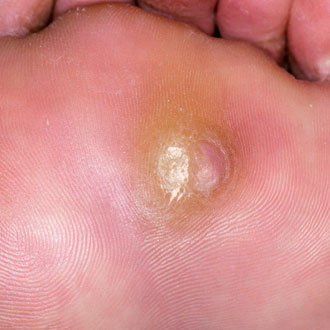The information – verrucas and warts

The patient’s unmet needs (PUNs)
‘I really need you to sort these out’ says the mum of your next patient, a 12-year-old girl. She indicates a crop of verrucas on the girl’s feet. ‘And they’re spreading, too,’ she explains, indicating warts on her daughter’s fingers – especially around the nails – and a couple on her face. ‘The other doctor told us they’d go eventually, but we’ve been waiting for months,’ she says. ‘And nothing we’ve bought from the chemist has helped at all. We’d like them frozen off – the school won’t let her go swimming until they’ve been treated.’
The doctor’s educational needs (DENs)
What is the natural history of warts and verrucas? Is there a strong argument for leaving them untreated?
Warts are common skin infections that most frequently arise on the hands or feet (plantar warts) in children, but may occur at any site and can affect adults. They are caused by the human papilloma virus (HPV) and have an incubation period of weeks or months. Without treatment, most warts in children will resolve within two years, but may take much longer in adults or in immunosuppressed individuals. Available therapies are not very effective and leaving them untreated is often the best option.1 Use of salicylic acid preparations is generally safe and is therefore most appropriate for uncomplicated warts if active treatment is deemed necessary by the child or carers. However, more invasive treatment should be considered if the warts are uncomfortable or painful, or if they are interfering with function. Multiple warts on the hands or face may be a significant cosmetic problem.
What are the pros and cons of cryotherapy for viral warts?
Using cold to kill skin infected with HPV is one method of treatment, but has to be used carefully and may cause considerable pain and local inflammation. Liquid nitrogen is more effective than other refrigerants, but the cure rate is less than 50% for hand warts and is probably ineffective for plantar warts.2 The application by cryo-spray or cotton bud is painful, and there is often blistering and crusting. There is a risk of secondary infection, and deep structures such as cutaneous nerves can be damaged by freezing. Cryotherapy may be poorly tolerated by children and usually has to be repeated at intervals of two to four weeks. There is a tendency to cause pigmentary change in darker skinned individuals, and this is can be a serious concern when treated lesions on the dorsum of the hands or the face. Surgical removal of warts might be an appropriate option in selected cases.
What other treatments have good evidence of benefit? What is the likelihood of recurrence?
Topical therapy with salicylic acid products is considered to be first-line treatment as it is relatively safe and easy to apply at home. The success rate of salicylic acid products used after soaking and abrading the skin is between 17% and 33% if used for 13 weeks, but compliance may be difficult to achieve and so it may be less effective in practice. Other topical treatments have been tried, but good quality evidence of efficacy is lacking and they are probably best avoided in primary care. Occlusion with ‘duct tape’ is no more effective than placebo.3 Warts may recur after topical therapy, cryotherapy or surgery but there are no long-term follow-up studies.
Is there any significant difference in the way verrucas and warts elsewhere should be treated? Do certain sites – such as facial or peri-ungual warts – cause any specific issues?
Topical treatment with salicylic acid is suitable for children and adults, but because of the pain of treatment, cryotherapy should generally not be considered in young children. Poor response to treatment means cryotherapy is less suitable for plantar warts.
Anecdotally, it seems that peri-ungual warts are more resistant to treatment. Filiform warts (projecting from the skin) on the face do well with cryotherapy applied by cotton bud. Cryotherapy for facial lesions should be approached very cautiously in darker skins because of the risk of causing hyper- or hypopigmentation. Sometimes resistant warts may be removed surgically, but this is not suitable for children, or where the warts are multiple and there is a risk of scarring.
What advice should we give parents worried about transmission – such as through changing room floors?
HPV can be spread by direct contact or through the environment and it is thought that wart virus that has been shed from the skin may persist for months or even years. Eradication of wart infection from the community will not be achieved by isolating affected individuals or covering warts, but schools or swimming pools may sometimes insist on children with plantar warts wearing plasters or plastic socks.
Dr Laurence Lever is a consultant dermatologist at Northwick Park Hospital, London.
References
1 Sterling JC, Handfield-Jones S, Hudson PM. Guidelines for the management of cutaneous warts. Br
J Dermatol, 2001;144(1):4-11
2 Bruggink SC, Gussekloo J, Berger MY et al. Cryotherapy versus salicylic acid application for cutaneous warts in primary care: randomized controlled trial. CMAJ, 2010;182(15):1624-30
3 Kwok CS, Holland R, Gibbs S. Efficacy of topical treatments for cutaneous warts: a meta-analysis and pooled analysis of randomized controlled trials. Br J Dermatol, 2011;165(2):233-46
Pulse July survey
Take our July 2025 survey to potentially win £1.000 worth of tokens

Visit Pulse Reference for details on 140 symptoms, including easily searchable symptoms and categories, offering you a free platform to check symptoms and receive potential diagnoses during consultations.











